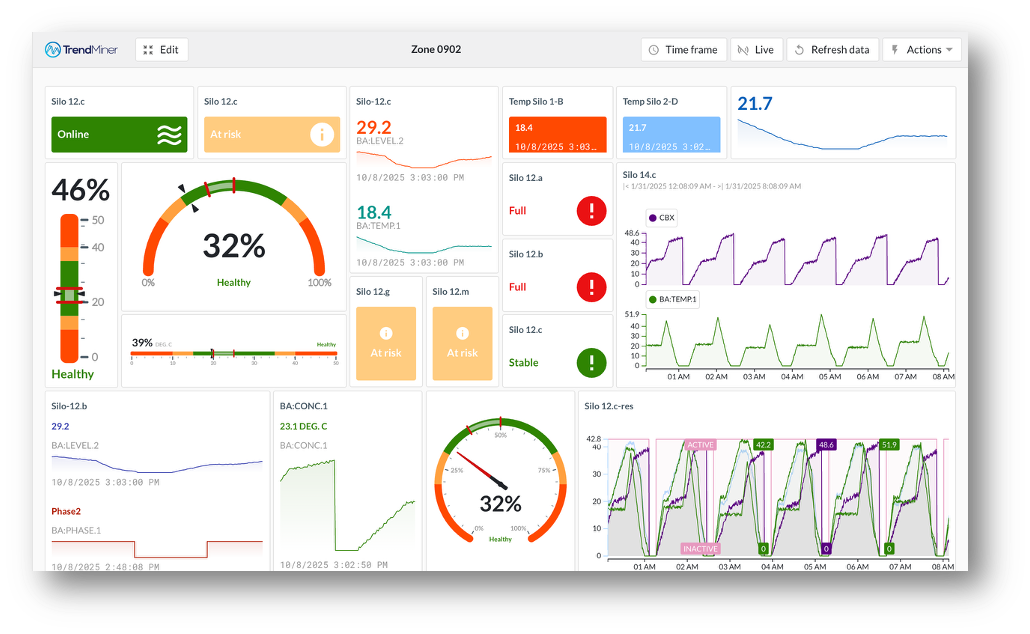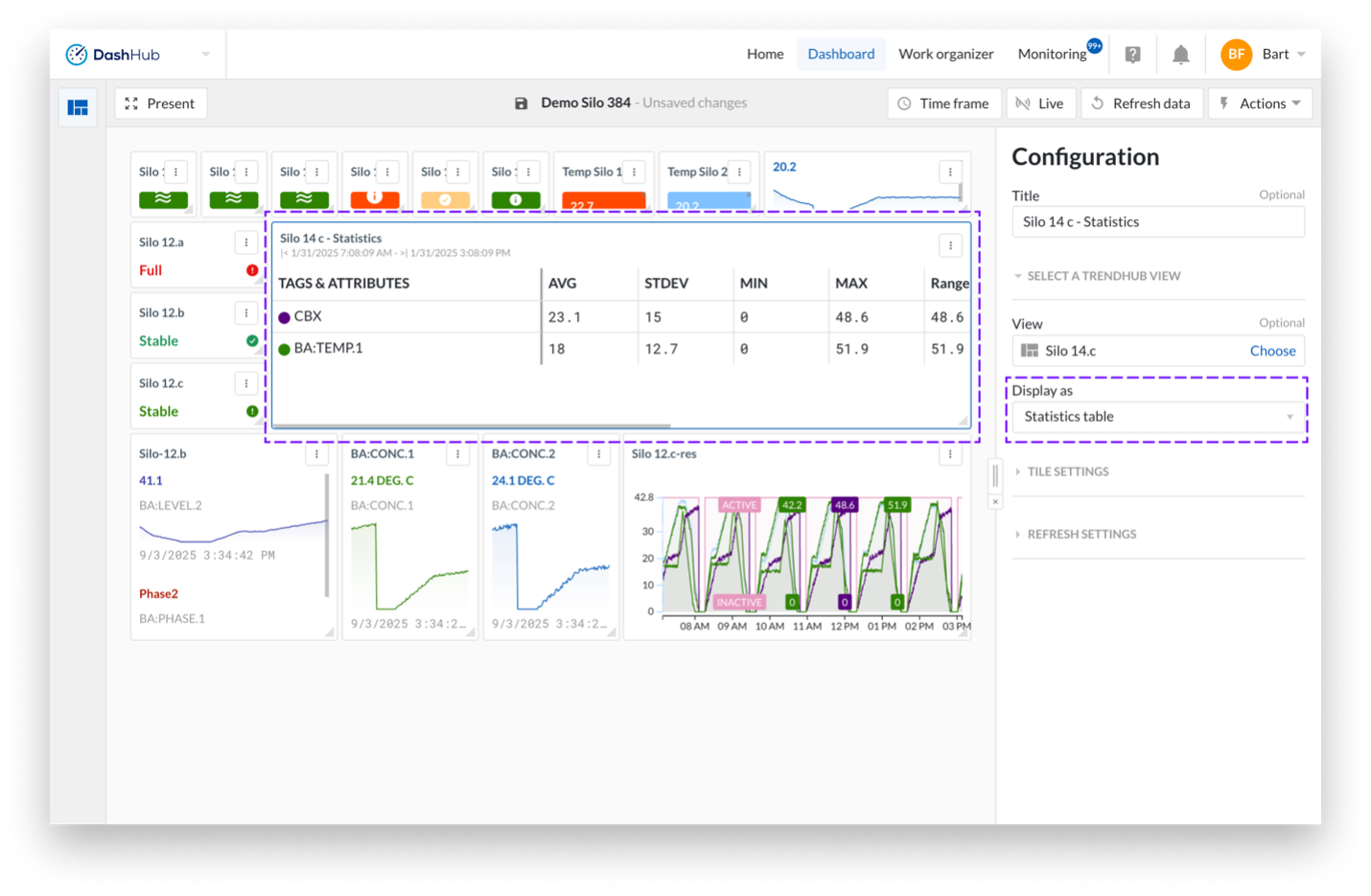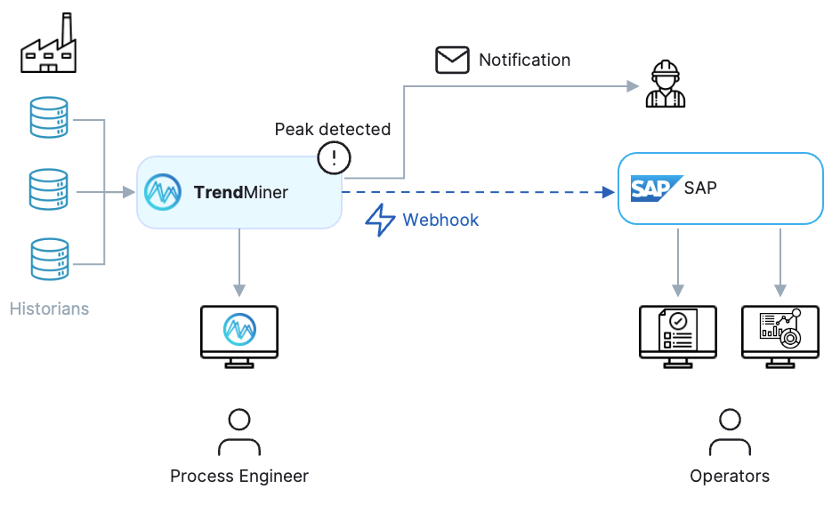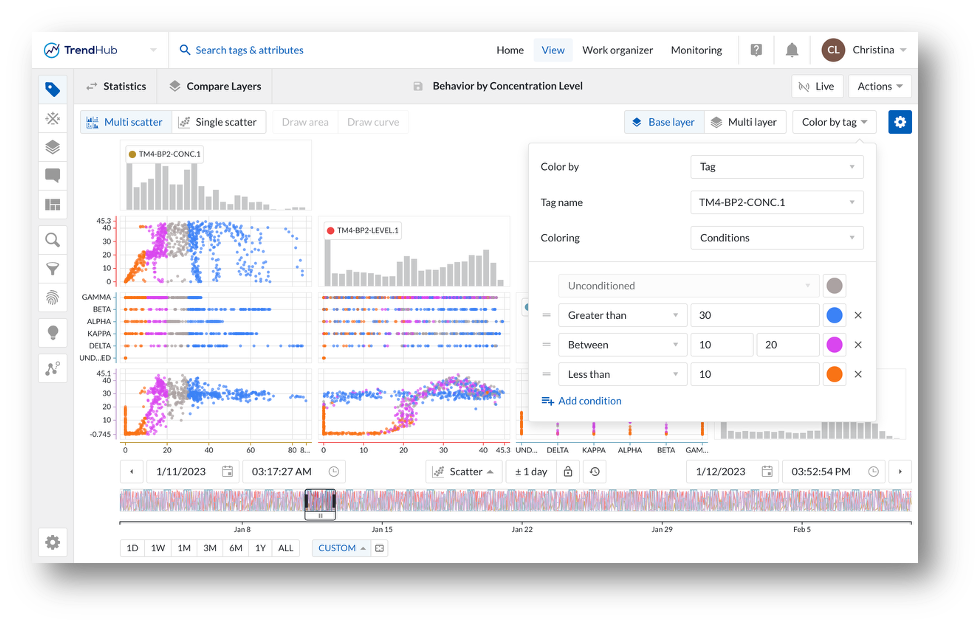Innovation Highlights
We're excited to announce our latest release with powerful new capabilities that help you collaborate across teams, visualize process performance, and connect TrendMiner with your operational ecosystem.
Sharing insights on the data you need is now simpler. Grant access to entire user groups instead of individual users, cutting down on administrative work and ensuring consistent access for users. New tag policies keep your system responsive with reduced priority of unused tags, ensuring the most crucial tags are up to date sooner.
New visualization tools help you understand process performance faster. Gauge tiles show status at a glance with customizable ranges and targets, perfect for control rooms. Statistics tables put key metrics right on your dashboards. Enhanced scatter plots now color by a third tag, revealing process relationships that speed up root cause analysis.
TrendMiner continues to connect deeper with your operational systems. Webhooks will now automatically trigger actions in your ERP, MES, or CMMS. Register batches, create work orders, or launch quality inspection, all without manual steps. This turns TrendMiner into an automation engine that powers smarter workflows.
This release helps make quicker decisions, analyze data with more detail, and see process health more clearly. Review the detailed notes below for specific features and technical considerations for your deployment.
Sharing items with User Groups
Building on the new permission engine introduced in 2025.R2, we have extended collaboration possibilities by enabling users to share items with user groups.
Instead of assigning permissions individually, you can now grant Read or Write access to entire groups of users at once. This makes it easier to manage access for larger teams, ensures consistency, and reduces the administrative overhead of sharing items one by one. With this enhancement, teams and departments can streamline collaboration and stay aligned on the same set of TrendMiner analyses and dashboards.
New DashHub tiles: Gauge and Statistics
DashHub now offers two new visualization options, the Gauge tile and Statistics option to help viewers better discern how a process is running.
Gauge Tile
The new Gauge tile brings your data to life by showing values from a selected component in an intuitive gauge-style visualization. You can compare values against defined ranges and targets, and instantly see whether a system or process is performing within acceptable limits.
The Gauge tile offers multiple display modes to suit different visualization needs:
Angular: Semi-circular layout for quickly spotting positive or negative outcomes, ideal for dashboards with multiple gauges.
Speedometer: Full circular dial for highlighting overall performance at a glance.
Linear (vertical/horizontal): Bar-style gauge for precise measurements or comparisons across metrics.
The tile is highly customizable to your use case, allowing you to show timestamps, range labels, ticks, target differences, and percentage-based displays, while coloring and alias settings help tailor it to your dashboard style.

Statistics Table display option
TrendHub View tiles can now be displayed on dashboards not only as trend, stacked, or scatter plots, but also as a statistics table. This new display mode lets you quickly consult key statistics of tags over the period of the view directly on the dashboard. This setting pairs nicely with global timeframes, adjusting calculations to your desired reporting window.

Webhooks
Note
This feature is not available by default, but it can be enabled “on-request”. Contact TrendMiner Support for assistance.
TrendMiner can automatically trigger actions in external systems (like ERP, MES, or CMMS) whenever events occur, such as context item creation, updates, or deletions, whether manually by a user or automated via a monitor.

This unlocks new automation scenarios: automatically registering a new batch in ERP, creating maintenance jobs when equipment hits usage thresholds, or triggering quality inspections when exceptions occur. Instead of just sending notifications, TrendMiner now enables real-time system-to-system interactions.
Webhooks are lightweight and configurable, enabling any external system to consume TrendMiner events. Turning TrendMiner into an automation engine, powering smarter workflows and reducing manual follow-up.
Extended coloring options in TrendHub’s Scatter Plot
This release introduces a powerful enhancement to the scatter plot visualization: the ability to color data points by a 3rd tag in single-layer mode. This feature enhances visual analysis by allowing users to assign colors and markers based on tag values, making it easier to explore scatter plot data, and interpret complex relationships, and uncover patterns and anomalies with greater precision.
Coloring Options for Analog and Discrete Tags
Gradient Coloring: Data points are colored along a continuous gradient based on the tag’s value range. This is similar to the original color by time gradient.
Condition-Based Coloring: Users can define numerical conditions (e.g., value > 75) to create distinct color categories. This is especially useful for highlighting thresholds or performance boundaries.
Markers: In addition to color, users can assign unique markers to each condition, improving visual clarity when multiple categories are present.

Coloring Options for Digital/String Tags
Select up to 10 states, each with a unique color and marker.
Ideal for visualizing categorical data such as equipment states or batch identifiers.
Introduction of a reduced indexing policy
TrendMiner continuously keeps all indexed tags up to date to ensure fast and reliable access to time-series data whenever users start an analysis. This indexing mechanism distributes load throughout the day and already supports the following update cycles:
Every 2 minutes for tags used in monitors (directly or via Tag Builder).
Every hour for actively used tags (default policy).
Never for tags that have not received any new data for a full year (introduced in 2025.R2.0).
With the current release, tags that have not been actively used in the past 7 days will automatically switch to a daily update cycle. This new Reduced Indexing Policy helps:
Lower the load on external data sources, minimizing unnecessary polling.
Enable more efficient use of TrendMiner system resources, allowing the platform to better prioritize and maintain up-to-date indexes for actively used tags.
Administrators can monitor and manage these tags via the Index Overview menu, using filters for update policy and delayed status. This policy is especially impactful in environments with large tag volumes, helping maintain a healthy and responsive indexing system.